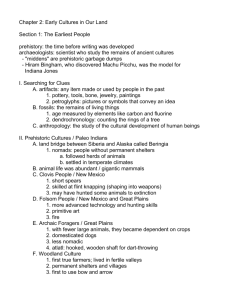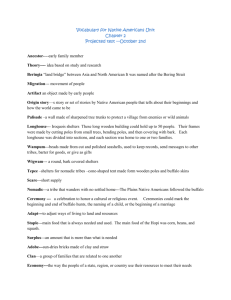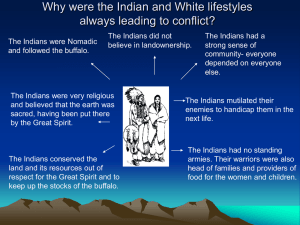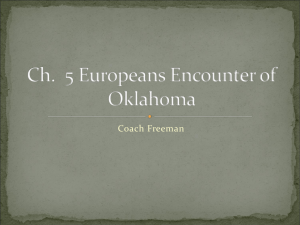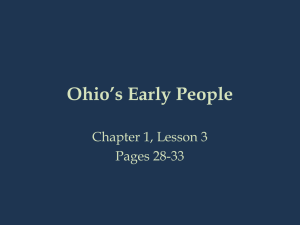Chapter 3 * Early Cultures in Our Land
advertisement
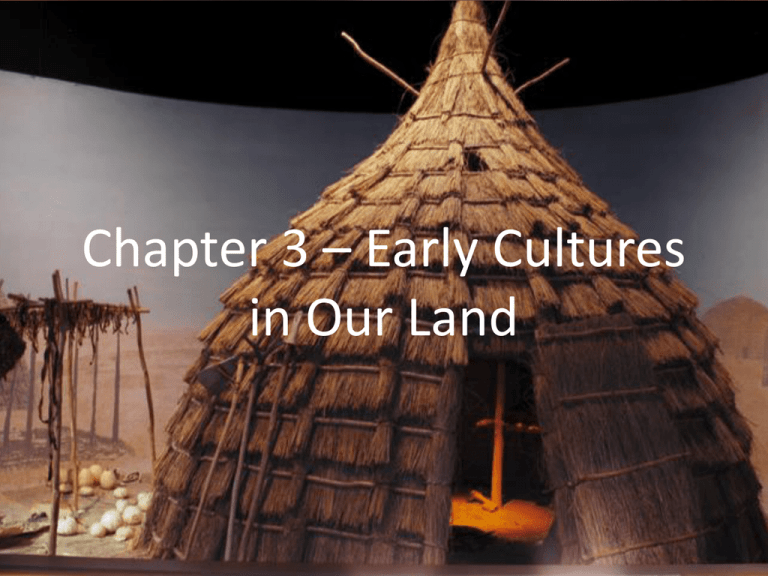
Chapter 3 – Early Cultures in Our Land I. The Earliest People • Prehistoric people – those who lived before recorded history • Archaeologists – scientists who study ancient cultures by examining what they have left behind A. Searching for Clues a. Artifacts can include any item made or used by people, such as pottery, tools, bone, jewelry, and paintings. Artifacts also include petroglyphs – pictures or symbols used to convey an idea. They may be discovered on the surface of the ground, on or near a waterway, or on an archaeological dig. b. Fossils, traces or remains of living things, also tell us about the lives of animals, birds, and people. Usually teeth, bones, or shells. c. Age of artifacts are determined in various ways. Carbon dating – isotope carbon 14 is analyzed to obtain age estimates on organic matter. DNA studies, fluorine dating (testing fluorine in bones and soils to determine age), and dendrochronology (counting the number of annual rings in wood). d. Anthropologists study artifacts, fossils, cave drawings, trails, and oral history to learn the culture of a group and how groups of people lived. Prehistoric people are identified by cultural periods. People learned from those who lived before them, discovered new things, and taught what they knew to their children. Cultural changes took place slowly and cultural periods in history overlapped, often by a thousand years or more. B. Prehistoric Cultures a. Some experts believe that the earliest people came to America from Asia. They crossed a “land bridge” between Siberia and Alaska known as Beringia. C. Paleo Indians a. Nomadic (wandering from place to place) biggame hunters followed the animals, their food source, deeper into America. Many animals of the day were much bigger than animals today. The enormous game animals of prehistoric Oklahoma included gigantic six-foot tall bison, short-faced bear, camel, horse, ground sloth, antelope, mastodon, and Columbian and Imperial mammoths. In 1961, scientists discovered evidence in southwestern Oklahoma of Paleo Indian prehistoric hunters. They found the bones of a Columbian mammoth at the Cooperton site it Kiowa County. Rocks also found at the site may have been used as hammerstones and as anvils to break the bones and retrieve the marrow, much as African tribes still do with elephant bones. b. Clovis People These people used spears for weapons which meant they had to be close to their prey. Some may have disguised themselves under animal pelts and some may have driven animals into natural traps or stampeded them over cliffs. Making spear points, a process known as flint knapping, required skill. In 1961 near Stecker, the Domebo Canyon site was discovered and revealed a young Columbian mammoth that was about 14 feet tall at the shoulder and would have weighed some 10 tons. As the mammoth population dwindled, Clovis people turned to bison for food. c. Folsom People Culture changes happen slowly, resulting in one culture overlapping the other. The Folsom spear point was smaller and had a finer point with more delicate fluting. Folsom sites in Oklahoma include the Cooper Bone-bed and the Waugh site. The spear points found were made from stone common to Austin and Amarillo, Texas and to northwestern Kansas. This suggests that the hunters were very mobile. For reasons unknown, the large animals of the Great Plains died out about ten thousand years ago. Smaller animals began to roam – deer, turkey, rabbit, raccoon, squirrel, wolf, coyote, antelope, prairie dog, and bison. They probably lived in small bands of families. Some evidence suggest that they built small, temporary houses with pole frames that were probably covered with hides or bushes. They knew how to make and use fire. They also carved knife handles, awls, and beads from bone and wood. The animals that they killed provided food, and hides were made into clothing, containers, and covers for shelters. They made tendons into thread and string and bones into tools and ornaments. D. Archaic Culture Foragers a. The Archaic culture were still hunters but modern types of animals were their prey. Dogs became domesticated during this time Increasing population of people and conflicts with other groups caused the Foragers to hunt in more localized areas. They harvested nuts, berries, roots, and seeds. They ground hard plant foods in small sandstone basins to crack the grains or to make flour. They stored the grains and flours in baskets made from reeds and plants. They used stone axes to dig plants and to cut trees and brush for shelters and tools. b. An important new weapon – atlatl. The atlatl was a short wooden shaft with a hook at the end that was used to throw darts with more force and accuracy. c. The Forager people may have been used shelters with pole frames to live in as they hunted in their areas. Some in northeastern Oklahoma used natural caves and bluff overhangs along the rivers as their shelter. d. The people ate buffalo, deer, antelope, elk, jack rabbit, cotton tail, coyote, wildcat, badger, eagle, wild turkey, and mice. They mixed ground pinon nuts with wild plums and berries to make round flat cakes similar to a doughnut. They knew how to start a fire with a wood drill. They made bags from prairie dog skins, sandals of yucca leaves with soles of cedar bark, colorful mats, rugs, baskets, and cradles. E. Woodland Culture a. Farming began to replace foraging as the Woodland culture emerged. The early farmers needed to stay in one place so they could plant, cultivate, and harvest their crops of pigweed, goosefoot, squash, corn, beans, and sunflowers. They began to build better shelters and live in villages. Four regions – Grand River area, Ouachita Mountains, Cimarron River, along the Canadian and Washita Rivers Cultivating was done by hand using wood sticks and hoes made from flint, bone, stone, or mussel shell. b. People made pottery by shaping clay that had been mixed with ground bone, shell ,or sand. They baked the shaped pot at a high temperature, causing it to become hard. d. The bow and arrow and other new tools came into use about this time. The bow and arrow made hunting easier. The ax, made of stone, was both a weapon and a tool. They developed an ax with a cutting edge on both sides. F. Plains Village Farms a. The Plains Village farming groups lived in Oklahoma about 1,200 to 500 years ago. These people grew corn, beans, squash, gourds, sunflowers, and tobacco. Women tended crops and made pottery while men hunted. They hunted bison and deer. b. Villages of about 100 people were scattered along the waterways. Square or rectangular houses were built with posts of red cedar or cottonwood. The walls were made of sticks or cane that were covered with a clayand-grass mixture. Artifacts found at the Ray Smith site in Beaver County suggest that the people may have participated in a trade system that extended to the Pacific Ocean. G. Moundbuilders a. About the same time as the Plains Village Famers, the moundbuilders signature mounds can been seen at the Spiro Mounds State Archaeological Park. The mounds were built by the Caddo people. The unique burials and artwork suggest they were part of the larger Mississippian culture. • b. Most of the Caddoan people lived in small farming communities in nearby countryside, with one large centrally located village. c. Both Spiro men and women painted themselves with colorful paints made from clays and ground-up rocks. Men wore flat-top haircuts, sometimes with Mohawk-type crests. Men were fine craftsmen who worked with stone, shell, and copper. They carved fancy stone tobacco pipes depicting people and animals. Women tended the crops, home, and children. They gathered persimmons, nuts, acorns, pecans, and wild fruit. They made blankets of buffalo hair, rabbit fur, and feathers. All members of the clan wore jewelry that was made from rope and string, pearls and seeds. d. 12 mounds in layers – one mound for burials, two were temples, and nine were houses e. The Spiro elite were part of a chiefdom. In a chiefdom, the highest ranking person has control over critical resources. This control was probably over military leadership and trade in luxury items. H. Early Plains Indians a. Protohistoric – the era between prehistoric and recorded history b. Buffalo were vitally important. The animals provided the people with food, clothing, shelter, and tools. Making jerky and pemmican (dried meat mixed with berries and fat) allowed the Early Plains Indians to use buffalo meat long after the animal had been killed. c. Their shelters were grass houses and conical tipis covered with buffalo hide. At first, they traveled on foot. They used dogs as pack animals, pulling a type of sled made of two poles and a net. The American Indian cultures of this time included a number of tribes and confederacies with different traditions, beliefs, and languages. II. Historic Indian Cultures A. First Encounters a. In 1601, Spaniard Juan de Onate explored western Oklahoma and met the Wichita. He called them “fair and open”. While they were truthful and honorable, they were frequently at war. The Wichita people were well-known traders and barters. Wichita villagers made agreements with French hunters in the mid-1700s. The French needed horses and hunting partners that the Wichita could provide. The Indians wanted European good such as metal tools and guns. The French probably lived with the Wichita in at least two locations referred to by archeologists as the Deer Creek and Bryson Paddock sites near Newkirk. B. Indian Cultures a. The Indians were different (languages) but were similar (believed in many gods and spirits that affected people on Earth). The believed in an afterlife where brave warriors and faithful women were rewarded and cowards and thieves were punished. They believed in cleansing themselves inside and out to purify their spirits. b. Life was sacred to all the Plains tribes. They had personal totems – an animal or bird whose spirit guided them. The shaman, or medicine man, used herbs and prayer to heal the sick. He interpreted dreams and signs. Indian history and beliefs were passed down by spoken word, often by the shaman. They believed all things were tied together and part of a whole. People were not seen as more important that animals or plants. Parents and older tribal members were shown great respect. Children were rarely punished. Honesty was expected and lying was not tolerated. c. Family • Marriages were permitted between related tribes. Polygamy, having more than one wife, was permitted if the husband could afford the expense. A boy would care for his parents in old age. A girl was a potential source of income, for she could be bartered when she became marriageable. The men were warriors and hunters. Experienced men taught young boys the skills of war and hunting and weaponry. The women took care of the shelter. Women could set up the tipi in as little as fifteen minutes. Because there were few trees on the plains, both the poles and the hides were moved from camp to camp. The top opening of the tipi and the door flap controlled the heat and smoke. Women also kept their families clothed and fed, and they gathered wild roots, berries, and other foods. d. Food – Women prepared the food; meats were eaten raw, roasted over an open fire, boiled in water, or dried. The women ground corn for breads and soups. When prepared with lye from wood ashes, the corn became hominy which was made into soup or a drink. They baked pumpkins and squash or dried them for use in stews. e. Plants – About 170 plants used by the American Indians have been identified as having medical value today. Digitalis, a heart medicine, is derived from the foxglove plant. Aspirin was originally made from willow bark. Bee balm and butterfly milkweed were used from bronchial problems, colds, or sore throats.
